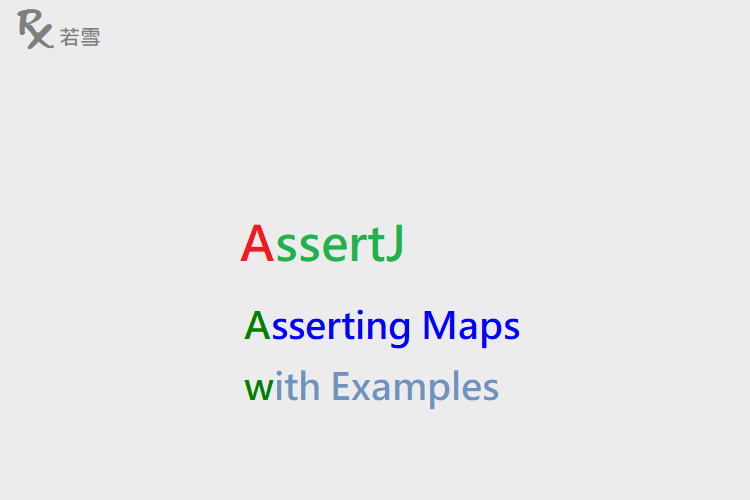Table of Contents
ToggleAsserting Maps in Java with Examples
提供了一組豐富的斷言和真正有用的錯誤訊息,提高了測試程式碼的可讀性,驗證符合、滿足條件的元素, Asserting Maps in Java 提供常見的方法,如: allMatch 、 allSatisfy 等,本篇增加了範例,並透過單元測試來驗證產出結果。
檔案目錄
./
+- src
+- test
| +- org
| +- ruoxue
| +- spring_boot_168
| +- test
| +- assertj
| +- map
| +- AssertingMapsWithExamplesTest.java
單元測試
Asserting Maps Java 斷言陣列的主要目的是取得陣列的正確元素以進行斷言。
Fruit
Asserting Maps Java 建立 Fruit 類別,覆寫 toString ,定義屬性和方法,用來建立一個物件。
@NoArgsConstructor
@Getter
@Setter
@Builder
public static class Fruit {
private String name;
private double quantity;
private int type;
private List<String> origins = new ArrayList<>();
public Fruit(String name, double quantity, int type, List<String> origins) {
this.name = name;
this.quantity = quantity;
this.type = type;
this.origins = origins;
}
public Fruit(String name, double quantity, int type) {
this(name, quantity, type, new ArrayList<>());
}
public String toString() {
ToStringBuilder builder = new ToStringBuilder(this, ToStringStyle.JSON_STYLE);
builder.appendSuper(super.toString());
builder.append("name", name);
builder.append("quantity", quantity);
builder.append("type", type);
builder.append("origins", origins);
return builder.toString();
}
}allSatisfy
Asserting Maps Java 驗證所有滿足條件的元素,若不成立,則會拋出 AssertionError 。
@Test
public void allSatisfy() {
Fruit grape = new Fruit("Grape", Double.MAX_VALUE, 2);
Fruit kiwifruit = new Fruit("Kiwifruit", 1, 2);
Fruit lemon = new Fruit("Lemon", -1, 2);
Map<String, Fruit> map = new HashMap<>();
map.put(grape.getName(), grape);
map.put(kiwifruit.getName(), kiwifruit);
map.put(lemon.getName(), lemon);
System.out.println(map);
assertThat(map).allSatisfy((k, v) -> {
assertThat(v.getType()).isEqualTo(2);
assertThat(v.getName()).isNotNull();
});
}{Grape={"name":"Grape","quantity":1.7976931348623157E308,"type":2}, Kiwifruit={"name":"Kiwifruit","quantity":1.0,"type":2}, Lemon={"name":"Lemon","quantity":-1.0,"type":2}}anySatisfy
Asserting Maps Java 驗證任一滿足條件的元素,若不成立,則會拋出 AssertionError 。
@Test
public void anySatisfy() {
Fruit grape = new Fruit("Grape", Double.MAX_VALUE, 1);
Fruit kiwifruit = new Fruit("Kiwifruit", 1, 2);
Fruit lemon = new Fruit("Lemon", -1, 3);
Map<String, Fruit> map = new HashMap<>();
map.put(grape.getName(), grape);
map.put(kiwifruit.getName(), kiwifruit);
map.put(lemon.getName(), lemon);
System.out.println(map);
assertThat(map).anySatisfy((k, v) -> {
assertThat(v.getType()).isEqualTo(2);
assertThat(v.getName()).isEqualTo("Kiwifruit");
});
}{Grape={"name":"Grape","quantity":1.7976931348623157E308,"type":1}, Kiwifruit={"name":"Kiwifruit","quantity":1.0,"type":2}, Lemon={"name":"Lemon","quantity":-1.0,"type":3}}noneSatisfy
Asserting Maps Java 驗證不滿足條件的元素,若不成立,則會拋出 AssertionError 。
@Test
public void noneSatisfy() {
Fruit grape = new Fruit("Grape", Double.MAX_VALUE, 1);
Fruit kiwifruit = new Fruit("Kiwifruit", 1, 2);
Fruit lemon = new Fruit("Lemon", -1, 3);
Map<String, Fruit> map = new HashMap<>();
map.put(grape.getName(), grape);
map.put(kiwifruit.getName(), kiwifruit);
map.put(lemon.getName(), lemon);
System.out.println(map);
assertThat(map).noneSatisfy((k, v) -> {
assertThat(v.getType()).isEqualTo(0);
assertThat(v.getName().length()).isLessThan(5);
});
}{Grape={"name":"Grape","quantity":1.7976931348623157E308,"type":1}, Kiwifruit={"name":"Kiwifruit","quantity":1.0,"type":2}, Lemon={"name":"Lemon","quantity":-1.0,"type":3}}hasEntrySatisfying
Java Asserting Maps 驗證 Entry 滿足條件的元素,若不成立,則會拋出 AssertionError 。
@Test
public void hasEntrySatisfying() {
Fruit grape = new Fruit("Grape", Double.MAX_VALUE, 1);
Fruit kiwifruit = new Fruit("Kiwifruit", 1, 2);
Fruit lemon = new Fruit("Lemon", -1, 3);
Map<String, Fruit> map = new HashMap<>();
map.put(grape.getName(), grape);
map.put(kiwifruit.getName(), kiwifruit);
map.put(lemon.getName(), lemon);
System.out.println(map);
Condition<Map.Entry<String, Fruit>> lengthQuantity = new Condition<>(
e -> e.getKey().length() > 6 && e.getValue().getQuantity() > 0, "length quantity");
assertThat(map).hasEntrySatisfying(lengthQuantity);
}{Grape={"name":"Grape","quantity":1.7976931348623157E308,"type":1}, Kiwifruit={"name":"Kiwifruit","quantity":1.0,"type":2}, Lemon={"name":"Lemon","quantity":-1.0,"type":3}}hasKeySatisfying
Java Asserting Maps 驗證 Key 滿足條件的元素,若不成立,則會拋出 AssertionError 。
@Test
public void hasKeySatisfying() {
Fruit grape = new Fruit("Grape", Double.MAX_VALUE, 1);
Fruit kiwifruit = new Fruit("Kiwifruit", 1, 2);
Fruit lemon = new Fruit("Lemon", -1, 3);
Map<String, Fruit> map = new HashMap<>();
map.put(grape.getName(), grape);
map.put(kiwifruit.getName(), kiwifruit);
map.put(lemon.getName(), lemon);
System.out.println(map);
Condition<String> length = new Condition<String>(s -> s.length() > 6, "length");
assertThat(map).hasKeySatisfying(length);
}[{"name":"Apple","quantity":1.7976931348623157E308,"type":1}, {"name":"Banana","quantity":1.0,"type":2}, {"name":"Cherry","quantity":-1.0,"type":3}]hasValueSatisfying
Java Asserting Maps 驗證 Value 滿足條件的元素,若不成立,則會拋出 AssertionError 。
@Test
public void hasValueSatisfying() {
Fruit grape = new Fruit("Grape", Double.MAX_VALUE, 1);
Fruit kiwifruit = new Fruit("Kiwifruit", 1, 2);
Fruit lemon = new Fruit("Lemon", -1, 3);
Map<String, Fruit> map = new HashMap<>();
map.put(grape.getName(), grape);
map.put(kiwifruit.getName(), kiwifruit);
map.put(lemon.getName(), lemon);
System.out.println(map);
Condition<Fruit> quantity = new Condition<Fruit>(o -> o.quantity > 0, "quantity");
assertThat(map).hasValueSatisfying(quantity);
}{Grape={"name":"Grape","quantity":1.7976931348623157E308,"type":1}, Kiwifruit={"name":"Kiwifruit","quantity":1.0,"type":2}, Lemon={"name":"Lemon","quantity":-1.0,"type":3}}AssertingMapsWithExamplesTest.java
Java Asserting Maps 新增單元測試,驗證是否符合預期。
package org.ruoxue.spring_boot_168.test.assertj.map;
import static org.assertj.core.api.Assertions.*;
import java.util.HashMap;
import java.util.Map;
import org.apache.commons.lang3.builder.ToStringBuilder;
import org.apache.commons.lang3.builder.ToStringStyle;
import org.assertj.core.api.Condition;
import org.junit.jupiter.api.Test;
import lombok.Builder;
import lombok.Getter;
import lombok.NoArgsConstructor;
import lombok.Setter;
public class AssertingMapsWithExamplesTest {
@NoArgsConstructor
@Getter
@Setter
@Builder
public static class Fruit {
private String name;
private double quantity;
private int type;
public Fruit(String name, double quantity, int type) {
this.name = name;
this.quantity = quantity;
this.type = type;
}
public String toString() {
ToStringBuilder builder = new ToStringBuilder(this, ToStringStyle.JSON_STYLE);
builder.appendSuper(super.toString());
builder.append("name", name);
builder.append("quantity", quantity);
builder.append("type", type);
return builder.toString();
}
}
@Test
public void allSatisfy() {
Fruit grape = new Fruit("Grape", Double.MAX_VALUE, 2);
Fruit kiwifruit = new Fruit("Kiwifruit", 1, 2);
Fruit lemon = new Fruit("Lemon", -1, 2);
Map<String, Fruit> map = new HashMap<>();
map.put(grape.getName(), grape);
map.put(kiwifruit.getName(), kiwifruit);
map.put(lemon.getName(), lemon);
System.out.println(map);
assertThat(map).allSatisfy((k, v) -> {
assertThat(v.getType()).isEqualTo(2);
assertThat(v.getName()).isNotNull();
});
}
@Test
public void anySatisfy() {
Fruit grape = new Fruit("Grape", Double.MAX_VALUE, 1);
Fruit kiwifruit = new Fruit("Kiwifruit", 1, 2);
Fruit lemon = new Fruit("Lemon", -1, 3);
Map<String, Fruit> map = new HashMap<>();
map.put(grape.getName(), grape);
map.put(kiwifruit.getName(), kiwifruit);
map.put(lemon.getName(), lemon);
System.out.println(map);
assertThat(map).anySatisfy((k, v) -> {
assertThat(v.getType()).isEqualTo(2);
assertThat(v.getName()).isEqualTo("Kiwifruit");
});
}
@Test
public void noneSatisfy() {
Fruit grape = new Fruit("Grape", Double.MAX_VALUE, 1);
Fruit kiwifruit = new Fruit("Kiwifruit", 1, 2);
Fruit lemon = new Fruit("Lemon", -1, 3);
Map<String, Fruit> map = new HashMap<>();
map.put(grape.getName(), grape);
map.put(kiwifruit.getName(), kiwifruit);
map.put(lemon.getName(), lemon);
System.out.println(map);
assertThat(map).noneSatisfy((k, v) -> {
assertThat(v.getType()).isEqualTo(0);
assertThat(v.getName().length()).isLessThan(5);
});
}
@Test
public void hasEntrySatisfying() {
Fruit grape = new Fruit("Grape", Double.MAX_VALUE, 1);
Fruit kiwifruit = new Fruit("Kiwifruit", 1, 2);
Fruit lemon = new Fruit("Lemon", -1, 3);
Map<String, Fruit> map = new HashMap<>();
map.put(grape.getName(), grape);
map.put(kiwifruit.getName(), kiwifruit);
map.put(lemon.getName(), lemon);
System.out.println(map);
Condition<Map.Entry<String, Fruit>> lengthQuantity = new Condition<>(
e -> e.getKey().length() > 6 && e.getValue().getQuantity() > 0, "length quantity");
assertThat(map).hasEntrySatisfying(lengthQuantity);
}
@Test
public void hasKeySatisfying() {
Fruit grape = new Fruit("Grape", Double.MAX_VALUE, 1);
Fruit kiwifruit = new Fruit("Kiwifruit", 1, 2);
Fruit lemon = new Fruit("Lemon", -1, 3);
Map<String, Fruit> map = new HashMap<>();
map.put(grape.getName(), grape);
map.put(kiwifruit.getName(), kiwifruit);
map.put(lemon.getName(), lemon);
System.out.println(map);
Condition<String> length = new Condition<String>(s -> s.length() > 6, "length");
assertThat(map).hasKeySatisfying(length);
}
@Test
public void hasValueSatisfying() {
Fruit grape = new Fruit("Grape", Double.MAX_VALUE, 1);
Fruit kiwifruit = new Fruit("Kiwifruit", 1, 2);
Fruit lemon = new Fruit("Lemon", -1, 3);
Map<String, Fruit> map = new HashMap<>();
map.put(grape.getName(), grape);
map.put(kiwifruit.getName(), kiwifruit);
map.put(lemon.getName(), lemon);
System.out.println(map);
Condition<Fruit> quantity = new Condition<Fruit>(o -> o.quantity > 0, "quantity");
assertThat(map).hasValueSatisfying(quantity);
}
}
心得分享
Java Asserting Maps Example 除了提供流式判斷,還針對 Array 做特殊判斷,在許多測試驗證的場景,讓開發者使用更流暢的驗證,不需要再寫迴圈,善用 Java Asserting Maps 將有助於驗證效率的提升。




